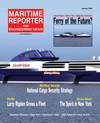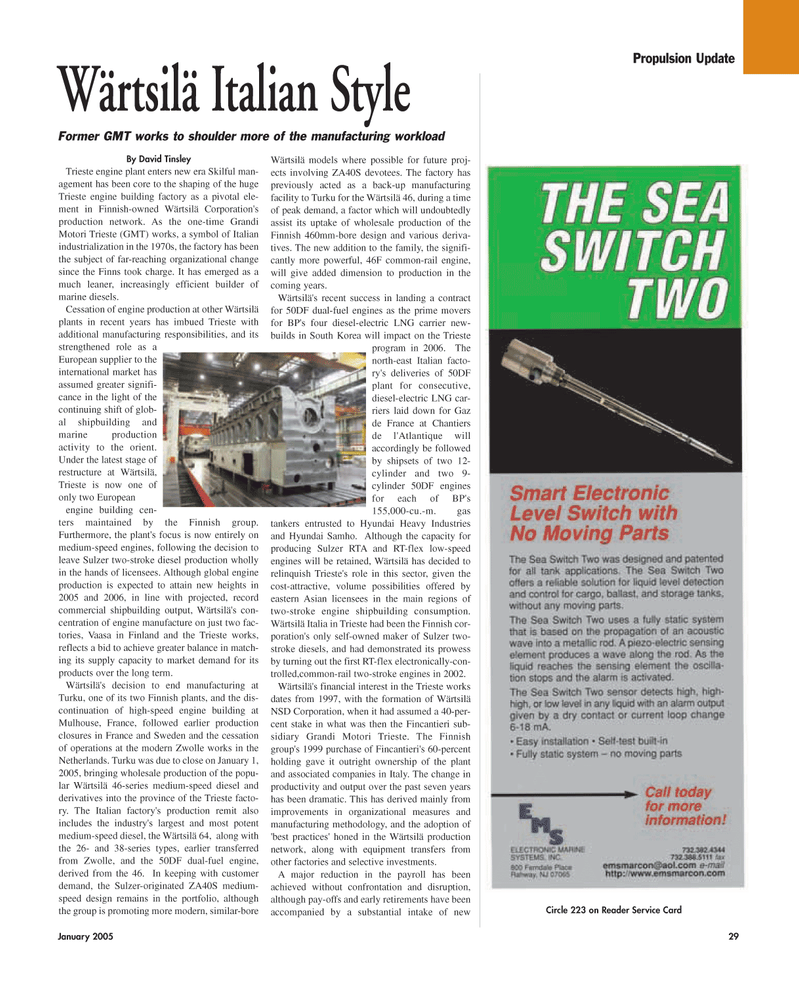
Page 29: of Maritime Reporter Magazine (January 2, 2005)
Read this page in Pdf, Flash or Html5 edition of January 2, 2005 Maritime Reporter Magazine
January 2005 29
By David Tinsley
Trieste engine plant enters new era Skilful man- agement has been core to the shaping of the huge
Trieste engine building factory as a pivotal ele- ment in Finnish-owned Wärtsilä Corporation's production network. As the one-time Grandi
Motori Trieste (GMT) works, a symbol of Italian industrialization in the 1970s, the factory has been the subject of far-reaching organizational change since the Finns took charge. It has emerged as a much leaner, increasingly efficient builder of marine diesels.
Cessation of engine production at other Wärtsilä plants in recent years has imbued Trieste with additional manufacturing responsibilities, and its strengthened role as a
European supplier to the international market has assumed greater signifi- cance in the light of the continuing shift of glob- al shipbuilding and marine production activity to the orient.
Under the latest stage of restructure at Wärtsilä,
Trieste is now one of only two European engine building cen- ters maintained by the Finnish group.
Furthermore, the plant's focus is now entirely on medium-speed engines, following the decision to leave Sulzer two-stroke diesel production wholly in the hands of licensees. Although global engine production is expected to attain new heights in 2005 and 2006, in line with projected, record commercial shipbuilding output, Wärtsilä's con- centration of engine manufacture on just two fac- tories, Vaasa in Finland and the Trieste works, reflects a bid to achieve greater balance in match- ing its supply capacity to market demand for its products over the long term.
Wärtsilä's decision to end manufacturing at
Turku, one of its two Finnish plants, and the dis- continuation of high-speed engine building at
Mulhouse, France, followed earlier production closures in France and Sweden and the cessation of operations at the modern Zwolle works in the
Netherlands. Turku was due to close on January 1, 2005, bringing wholesale production of the popu- lar Wärtsilä 46-series medium-speed diesel and derivatives into the province of the Trieste facto- ry. The Italian factory's production remit also includes the industry's largest and most potent medium-speed diesel, the Wärtsilä 64, along with the 26- and 38-series types, earlier transferred from Zwolle, and the 50DF dual-fuel engine, derived from the 46. In keeping with customer demand, the Sulzer-originated ZA40S medium- speed design remains in the portfolio, although the group is promoting more modern, similar-bore
Wärtsilä models where possible for future proj- ects involving ZA40S devotees. The factory has previously acted as a back-up manufacturing facility to Turku for the Wärtsilä 46, during a time of peak demand, a factor which will undoubtedly assist its uptake of wholesale production of the
Finnish 460mm-bore design and various deriva- tives. The new addition to the family, the signifi- cantly more powerful, 46F common-rail engine, will give added dimension to production in the coming years.
Wärtsilä's recent success in landing a contract for 50DF dual-fuel engines as the prime movers for BP's four diesel-electric LNG carrier new- builds in South Korea will impact on the Trieste program in 2006. The north-east Italian facto- ry's deliveries of 50DF plant for consecutive, diesel-electric LNG car- riers laid down for Gaz de France at Chantiers de l'Atlantique will accordingly be followed by shipsets of two 12- cylinder and two 9- cylinder 50DF engines for each of BP's 155,000-cu.-m. gas tankers entrusted to Hyundai Heavy Industries and Hyundai Samho. Although the capacity for producing Sulzer RTA and RT-flex low-speed engines will be retained, Wärtsilä has decided to relinquish Trieste's role in this sector, given the cost-attractive, volume possibilities offered by eastern Asian licensees in the main regions of two-stroke engine shipbuilding consumption.
Wärtsilä Italia in Trieste had been the Finnish cor- poration's only self-owned maker of Sulzer two- stroke diesels, and had demonstrated its prowess by turning out the first RT-flex electronically-con- trolled,common-rail two-stroke engines in 2002.
Wärtsilä's financial interest in the Trieste works dates from 1997, with the formation of Wärtsilä
NSD Corporation, when it had assumed a 40-per- cent stake in what was then the Fincantieri sub- sidiary Grandi Motori Trieste. The Finnish group's 1999 purchase of Fincantieri's 60-percent holding gave it outright ownership of the plant and associated companies in Italy. The change in productivity and output over the past seven years has been dramatic. This has derived mainly from improvements in organizational measures and manufacturing methodology, and the adoption of 'best practices' honed in the Wärtsilä production network, along with equipment transfers from other factories and selective investments.
A major reduction in the payroll has been achieved without confrontation and disruption, although pay-offs and early retirements have been accompanied by a substantial intake of new
Circle 223 on Reader Service Card
Propulsion Update
Wärtsilä Italian Style
Former GMT works to shoulder more of the manufacturing workload
MR JANUARY 2005 #4 (25-32).qxd 1/5/2005 3:31 PM Page 5

 28
28

 30
30
